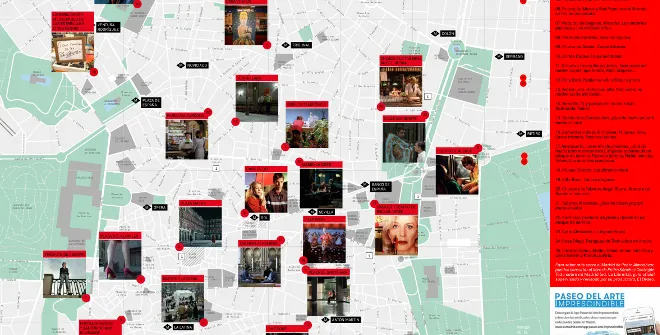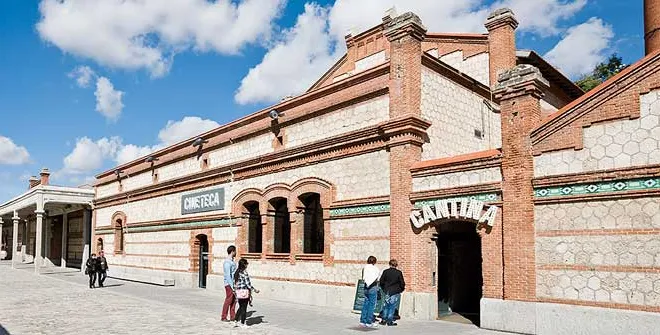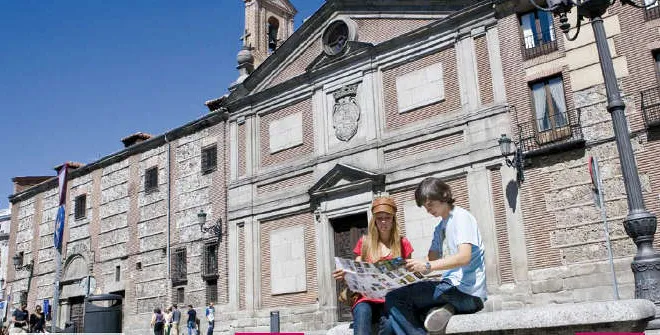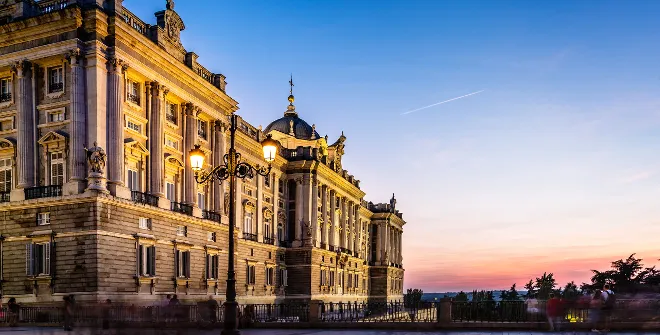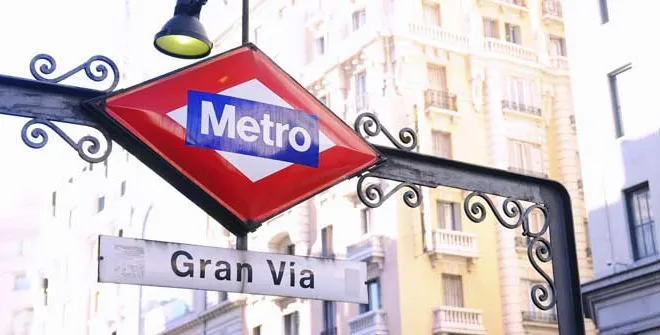Pedro Almodovar's Madrid
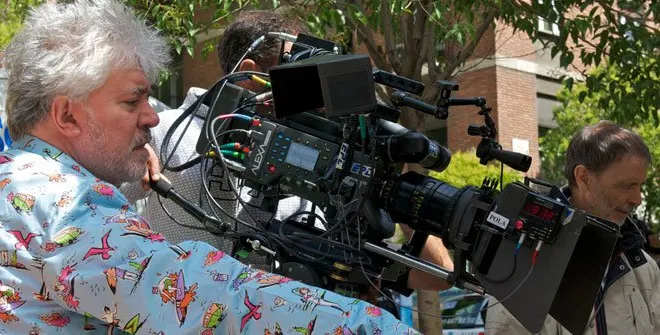
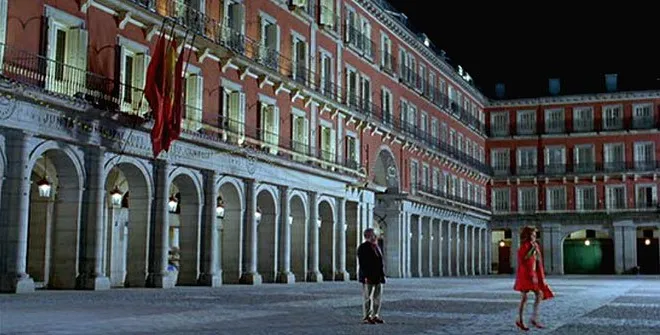
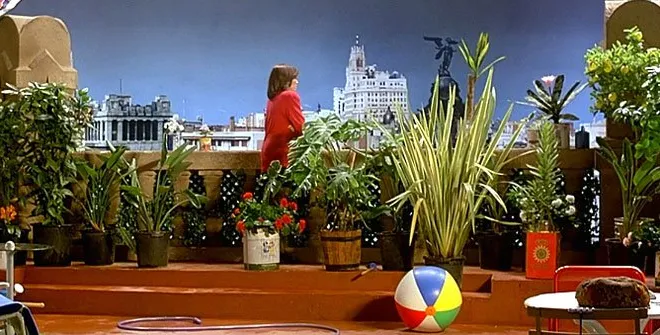
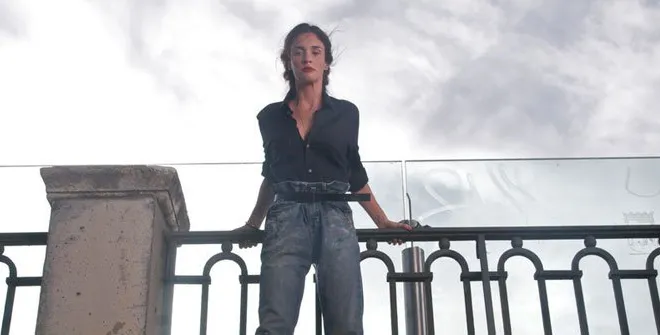
The curious spectator watches Almodóvar’s films and tries to recognise the various locations around the city. Some have become iconic symbols of the director’s universe. Others, on the other hand, are not easily recognisable. These are some interesting anecdotes about some of the hundreds of locations which make up Almodóvar’s Madrid.
Almodóvar – Spanish filmmaker, scriptwriter and producer – has been granted a great many international awards, including the Academy Award for Best Foreign Language Film for All About My Mother (1999) and the Academy Award for Best Original Screenplay for Talk to Her (2003), the Ariel Award for Best Ibero-American Film for Pain and Glory (2019), and a bunch of Goya Awards.
The M-30 Houses
At the end of What Have I done to Deserve This?, the camera pans away from the enormous blocks of flats where the main characters live, gradually fading away into the ocean of buildings of the big city. The three blocks are located alongside the M-30, close to the mosque, in the La Concepción neighbourhood. Almodóvar had first noticed them years earlier: “When I used to work in a Telefonica warehouse, close to Fuencarral, I would drive down the M-30 every day. I was always struck by those enormous hives at the side of the motorway”.
La Bobia
Seductive looks and a lot of flirting at this cafeteria, now known as La Bobia (Duque de Alba, 3), in El Rastro. It is a legendary spot on the Madrid Scene and plays an essential role in Labyrinth of Passion. It is the setting for the opening scene and the torrid encounter between the two main characters played by Imanol Arias and Cecilia Roth.
Conde Duque
(Conde Duque, 9) “Water me! Don’t be shy!”. Standing outside what is now the Conde Duque cultural center, the character played by Carmen Maura asks a municipal worker to provide some respite from the suffocating summer heat in Law of Desire, giving us one of the director's most famous scenes.
La Calle de Arenal
Almodóvar shot the ending of Live Flesh on Calle Arenal, taking advantage of the Christmas decorations. One of the shots was going to include the Museo del Jamón located at the beginning of the street. The director shot the scene incognito from inside a van, and the street was full of pedestrians and extras hired for the occasion. When he examined the takes after several hours of shooting, Almodóvar realised that there was a man waiting at the door of the bar in every single shot. “I suppose he’d arranged to meet someone who never turned up”. The man in question was wearing glasses, and can be seen briefly at the end of the film.
Postcard-perfect Madrid
Almodóvar’s journey through Madrid has little in common with that taken by the tour buses. There are a couple of exceptions: the Plaza Mayor in The Flower of My Secret. And above all, the night panorama over the Puerta de Alcalá which serves as a backdrop to the opening credits of Live Flesh.
A Cardboard City
In Kika, the director did very little filming in recognisable locations. Nonetheless, he did include certain symbols of the city. In one of the rooms in the house, there are cardboard models of the Madrid Tower, the Kio Towers and the Europa Tower. Yet more cardboard: the decorative landscape in the background of Veronica Forque’s apartment is a model of the Picasso Tower. The skyscraper, once the tallest in Madrid, is seen again in Broken Embraces: the view from the office where the tycoon, played by José Luís Gómez, works.
Cemeteries, Trains and Airports
The most frequent locations in Almodóvar’s films are the cemetery of La Almudena, and Madrid-Barajas Airport. Always aware of the new developments in the city, in Kika, the director shot in the new AVE station in Atocha, with the arrival of Peter Coyote on the luxury train. Some years later, in All About My Mother, Cecilia Roth travelled between Madrid and Barcelona by AVE. However, Almodóvar was ahead of the times; the AVE had not yet reached the Catalan capital.
Museo Chicote Cocktail Bar
One of the main scenes in Broken Embraces was shot in this legendary cocktail bar (Gran Vía, 12) which has been visited by the brightest Spanish and international stars. If the walls of Chicote could talk they would tell us how Ava Gardner seduced the renowned bullfighter Luis Miguel Dominguín. In Broken Embraces, Blanca Portillo plays a character, who, aided by G&Ts, reveals the truth, which had remained hidden for so many years.
Crown of Thorns
The headquarters of the Spanish Historic and Artistic Heritage Institute (El Greco, 4. Ciudad Universitaria), known as the Crown of Thorns, is the venue for the revengeful character played by Antonio Banderas in The Skin I Live In to give a conference. Architect Richard Rogers described the building as "creative and energetic in every way, down to the last detail". Designed by architects Fernando Higueras and Antonio Miró in an organic style, its construction started in the mid-60s. Almodóvar chose to shoot that part of the film there because he felt it added much expressiveness to the scene.
Segovia Viaduct
Although it didn't open till 1949, the city's viaduct is a great example of Madrid’s 1930s Rationalist style. A bridge between the Royal Palace and the area of Vistillas, most of Madrid's inhabitants invariably associate it with suicide. This inescapable link with death is touched on in Matador, a film about passion taken to the extreme, and even more so in one of his latest films, I’m So Excited. In it, a provocative comedy filmed almost entirely in a studio, the character played by Paz Vega is involved in a suicide attempt on this very spot.
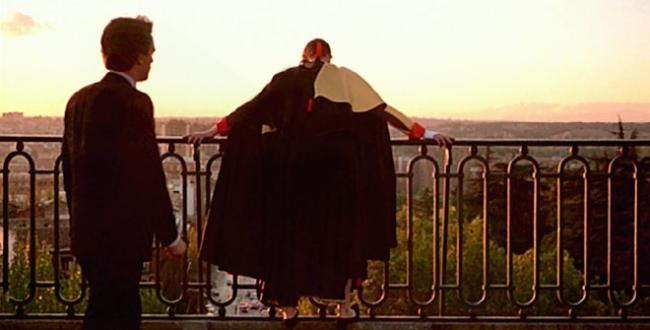
Doré Cinema
The headquarters of the Spanish Film Library (Santa Isabel, 13) appears in two films. The first was Talk to Her, when Benigno (played by Javier Cámara) went to see the short film, El Amante Menguante, included in the film. In his latest and most personal film, Pain and Glory, Antonio Banderas, alter ego of Almodóvar himself, pays tribute to them, which leads to a hilarious scene.
Other “Almodovar” Streets and Corners
- Calle Montalbán, 7. The seventh-floor attic was home to Pepa (Carmen Maura) in Women on the Verge of a Nervous Breakdown.. The Gran Vía skyline with the towering Telefónica building can be seen in the background.
- Calle Almagro, 38. Home to the family of Antonio Banderas in Women on the Verge of a Nervous Breakdown.
- Calle de Sevilla, 3. Casa de Kika en Kika.
- Villa Rosa (Plaza de Santa Ana, 15). The establishment in which the drag queen, Miguel Bosé, performed in High Heels.
- Teatro María Guerrero (Tamayo and Baus streets). Theatre in which Marisa Paredes sang in High Heels.
- Café del Círculo de Bellas Artes (Calle Alcalá, 42). The place where Victoria Abril and Peter Coyote met to discuss the script in Kika.
- Plaza del Alamillo. The setting for the basement- caretaker’s house where Marisa Paredes lived in High Heels.
- Plaza de Puerta de Moros. Place where the character of Leo (Marisa Paredes) tries to remove her ankle boots at the beginning of The Flower of My Secret.
- Paseo de Eduardo Dato, 18. Home to Javier Bardem and Francesca Neri in Live Flesh.
- Calle Segovia. The character played by Lluis Homar in Broken Embraces lives in this area under the Viaduct.
- Cock (Calle Reina, 16). Tamar Navas worked here as a disc-jockey in Broken Embraces.
Pedro Almodóvar left his village, Calzada de Calatrava, to come to the capital. His evolution as a person and an artist is closely linked to Madrid, a city which plays another role in his films and whose transformation in recent decades is skilfully reflected.
Pedro Almodóvar arrived in Madrid via the Extremadura motorway. According to an autobiographical article published in Diario 16 in 1993, his first contact with the city was to prove to be something of a disappointment. “It was nothing like how I had imagined it; the landscape was colourless, grimy and unwelcoming”.
At that stage Almodóvar was 17 years old, and convinced that his village was a prison for his artistic impulses. He had betrayed his family’s desire to see him working in a bank as an upright citizen, and much to their dismay, had packed his bags for a brighter future. All of his life’s dreams were connected to Madrid in some misty part of his imagination.
[[{"fid":"182725","view_mode":"full","fields":{"format":"full","field_file_image_alt_text[und][0][value]":"Pedro Almodovar - 1988","field_file_image_title_text[und][0][value]":"Pedro Almodovar - 1988","field_folder[und]":"2638"},"type":"media","attributes":{"alt":"Pedro Almodovar - 1988","title":"Pedro Almodovar - 1988","height":335,"width":660,"class":"media-element file-full","data-picture-mapping":"ckeditor_responsive"},"link_text":null}]]
In that same article, Almodóvar recalled his mother’s stories of having travelled to Madrid in the 1920s, and attracted by these fantastic tales, Pedro imagined that life in Madrid would be like living the life of the films of Empress Sissy. As time passed, in his mind Madrid became the place of shopping by catalogue, represented by the Galerias Preciados building. “I remember the catalogues, with their black and white photographs of all types of beauty and household products. It was my first contact with pop culture, and I will never forget it”.
His image of that legendary city changed with age and, by the time he was an adolescent, it had become a dream of freedom. “It represented the place where films were released before anywhere else, and also the place where everyone made their lives. To sum up, it was a dream”.
But Pedro arrived via the Extremadura motorway, which bears any resemblance to the gardens of the Empress Sissy, neither then nor nowadays. Then – he would later recount- he had to get used to the smell of the underground, and the fact that you cannot see the stars at night. “Those were the first feelings I can recall, not exactly fascinating, but I did stay”.
New York has Woody Allen, Rome has Fellini, and Madrid is lucky enough to have Pedro Almodóvar. This has happened without any perceptible effort on behalf of the city or the director. Unlike Allen or Fellini, Almodóvar has never paid tribute to the city, or made any public declaration of his love for the place. Their relationship has arisen much more naturally, as both realised that they were leading parallel lives.
Madrid is essential to the understanding of Pedro Almodóvar's films: it has become one of his many characters. The director himself has said so in the past: "This city has always provided me with the perfect fauna (sassy and ideal) for each and every one of my films". In Broken Embraces, Almodóvar brings together two settings Lanzarote and Madrid, which complement the plotline. A little tribute is even paid to the city in the movie poster of Girls and Suitcases, a film within the film, which shows a blonde Penélope Cruz standing among tall, emblematic buildings in Madrid.
Almodóvar and Madrid have evolved at the same time: from provincial children to international and cosmopolitan adults, while never entirely losing their rural roots. In Madrid, Almodóvar found the ideal stage for his paradoxical world view. A place in which the most avant-garde design lives happily alongside a tacky dressing gown
Outside Madrid, the spectators of Women on the Verge of a Nervous Breakdown took the idea of Carmen Maura breeding hens on her attic terrace to be a stroke of genius, but at the end of the day, these are the contradictions which make the city what it is. The same can be said of Almodóvar, who has used the city as his mirror. It was simply a question of looking without fear, and knowing where to look. In the most natural way, Almodóvar has given names to the places where his characters live their lives.
[[{"fid":"182726","view_mode":"full","fields":{"format":"full","field_file_image_alt_text[und][0][value]":"Mujeres al borde de un ataque de nervios","field_file_image_title_text[und][0][value]":"Mujeres al borde de un ataque de nervios","field_folder[und]":"2638"},"type":"media","attributes":{"alt":"Mujeres al borde de un ataque de nervios","title":"Mujeres al borde de un ataque de nervios","height":335,"width":660,"class":"media-element file-full","data-picture-mapping":"ckeditor_responsive"},"link_text":null}]]
The attic with the hens is located in Calle Montalbán, and the serial killer featured in the film is called the serial killer of Cuatro Caminos, the rapist in Kika is named the rapist of Orcasitas, and the weary protagonist of What Have I Done to Deserve This? lives her life in the Barrio de la Concepción. Oddly enough, in spite of the constant local references, the films became worldwide box office hits: “There are certain local features in my films which are easy to understand elsewhere, in New York for example. Life in large cities is similar everywhere, the discomfort is identical, and in spite of the cultural differences, they are more and more interconnected”.
Anyone wishing to study the evolution of Madrid over the last 25 years would be unable to do so without analysing the films of Almodóvar. The three stars of Pepi, Luci, Bom and other Girls on the Heap are a combination of rustic and urban characteristics, going from the most fashionable disco to knitting on the sofa. The Madrid of Labyrinth of Passion is the Madrid of the Rastro, the bubbling and fun-loving city of “la movida” (Madrid Scene).
In the words of one of its more outrageous characters, the Emperor of Tirán, it is “the most exciting city in the world”. The convent in Dark Habits (1983) is situated in the heart of the city, in Calle Hortaleza, and on a more realistic note, in What Have I Done To Deserve This? (1984), the director portrayed the outskirts of Madrid with its barren land and lizards.
Much like the city’s evolution, Almodóvar’s career went full speed ahead. If he wished to deal with death, there could be no better metaphor than the aqueduct in Calle Bailén, a traditional place for suicides. For this reason, Pedro chose this as his location for Matador (1985), a film which was also shot in Casa de Campo Park and Matadero in Legazpi. In a night scene in The Law of Desire (1986), Carmen Maura asks a street cleaner to hose her down. Of that scene, the director has commented, “I believe that that image is the best representation of what we call desire”. It is a scene which is also the best depiction of the suffocating Madrid summer nights yet to be seen on the big screen.
Every scene, every corner of Madrid which appears in his films has an explanation. At times symbolic, but at other times autobiographical, and why not? Almodóvar chose the Gran Vía as the backdrop for his film Women on the Verge of a Nervous Breakdown (1987), with the Telefonica building, home of his previous employers, clearly visible in the background. “It’s one of my favourite landscapes”. The student of Madrid’s evolution will also notice changes in the human geography of the capital. Before becoming the gay neighbourhood of Madrid, Chueca was home to junkies and low-lifes, as evidenced by the night scenes of Antonio Banderas in Tie me up, tie me down (1989).
As his international fame grew, Almodóvar became a type of ambassador of Madrid, although it became progressively harder for him to keep his finger on the pulse of the city. “I’ve always enjoyed the company of others, I’ve always liked meeting new people, listening to conversations, mixing with others and observing, that’s where I take my inspiration, but now I find it more difficult to get close to reality”.
Perhaps this is why High Heels (1991) and Kika (1993) were both shot indoors. On the other hand, some scenes of The Flower of My secret (1995) explore some of the city’s more emblematic locations. The writer played by Marisa Paredes lives and works in the Plaza de la Paja, and in one of the film’s most charming scenes, Juan Echanove tap dances in the Plaza Mayor at night.
[[{"fid":"182727","view_mode":"full","fields":{"format":"full","field_file_image_alt_text[und][0][value]":"La flor de mi secreto (1995)","field_file_image_title_text[und][0][value]":"La flor de mi secreto (1995)","field_folder[und]":"2638"},"type":"media","attributes":{"alt":"La flor de mi secreto (1995)","title":"La flor de mi secreto (1995)","height":335,"width":660,"class":"media-element file-full","data-picture-mapping":"ckeditor_responsive"},"link_text":null}]]
Twenty-five years had passed since his arrival in the city. “I grew up, had fun, suffered, put on weight and matured in Madrid. Many of those things I did at the same rate as the city itself” Almodóvar wrote in 1998, when he decided to look back for the first time, and reflect on so many changes.
The story of Live Flesh (1997) begins with the birth of a child during Christmas 1970, with the country in a state of emergency. At the end of the film, that child, Liberto Rabal, is about to have a child of his own. “When I was born, people were at home, shitting themselves with fear”, the main character tells his son. “Luckily for you my son, people in Spain lost that fear a long time ago”. What’s more, in that film Almodóvar found one of the more dramatic locations in his films: La Ventilla, a shanty town of crumbling shacks about to be demolished to make way for the modern leaning towers of Plaza Castilla. Once again, we find Madrid and Almodóvar full of contrasts and contradictions.
Up to that moment, he had made twelve feature films, twelve distinct visions of the city. Number 13 was something of a surprise. When he announced that he would shoot All About My Mother (1999) in Barcelona, Pedro could not hide certain feelings of guilt. He declared, “I feel I have betrayed Madrid”. He shot a film in Barcelona for the history books and then, as if he wished to stress that it was an exception, he returned to the old Madrid in Talk To Her. He returned to the street corners (“I have a thing for corners”) and to the houses with balconies and flower pots.
Over the years, he has received all manner of tempting offers. To make a film in the USA, or to shoot a film in English, but the director has no intention of moving. Madrid is a modern city, but at the same time it is almost La Mancha. Who knows, perhaps if he were to leave, he would have the same experience as Marisa Paredes, returning to the capital in High Heels:
- My God. How has the city changed so much?
- There are parts that you won’t recognise.
- What worries me is that the city won’t recognise m
